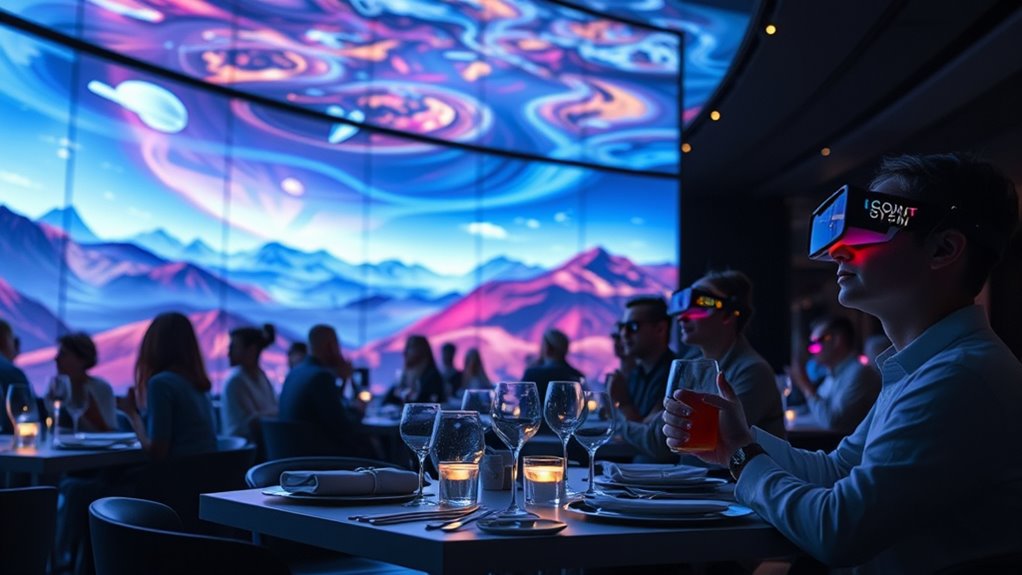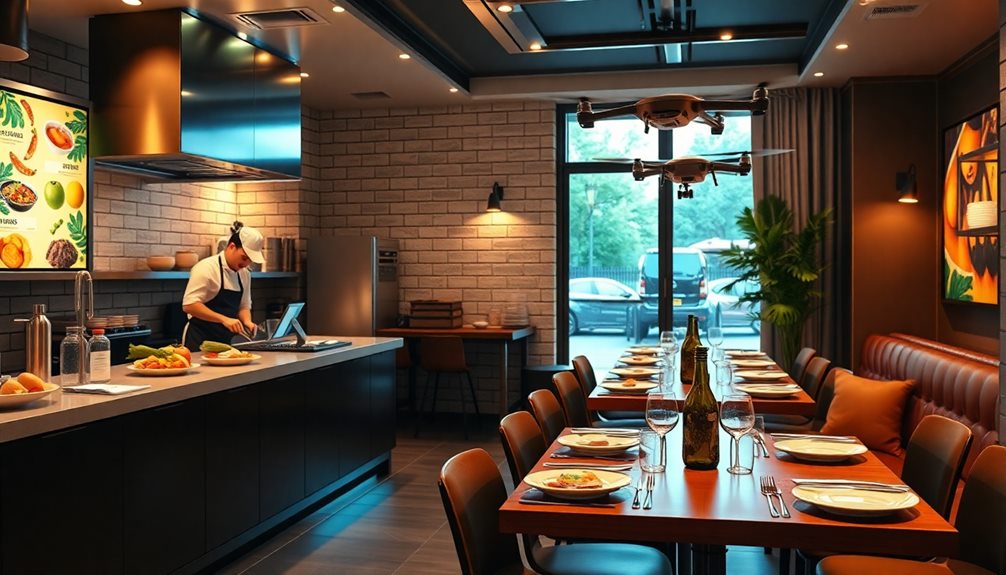Experiential dining with immersive tech transforms your meals into multi-sensory adventures. You can explore virtual reality tours of farms or exotic locations, interact with augmented reality overlays showing dish origins and recipes, and enjoy dynamic installations that engage your senses through visuals, sounds, and touch. The latest innovations let you customize dishes, enjoy themed environments, and participate actively in your dining story. Keep exploring to discover how these cutting-edge trends are shaping unforgettable culinary moments.
Key Takeaways
- Immersive tech like AR and VR create multi-sensory dining experiences, showcasing dishes and storytelling beyond traditional methods.
- Interactive installations and multisensory elements engage guests through visuals, sounds, textures, and aromas, enhancing enjoyment.
- Digital menus and contactless tech streamline ordering, while AR overlays visualize dishes, customization options, and ingredient origins.
- Themed environments utilize projection mapping, smart lighting, and interactive displays to deepen immersive storytelling.
- Future trends focus on multisensory cues, virtual pairing environments, and personalized experiences despite high costs and technical challenges.
The Evolution of Dining Experiences Through Technology
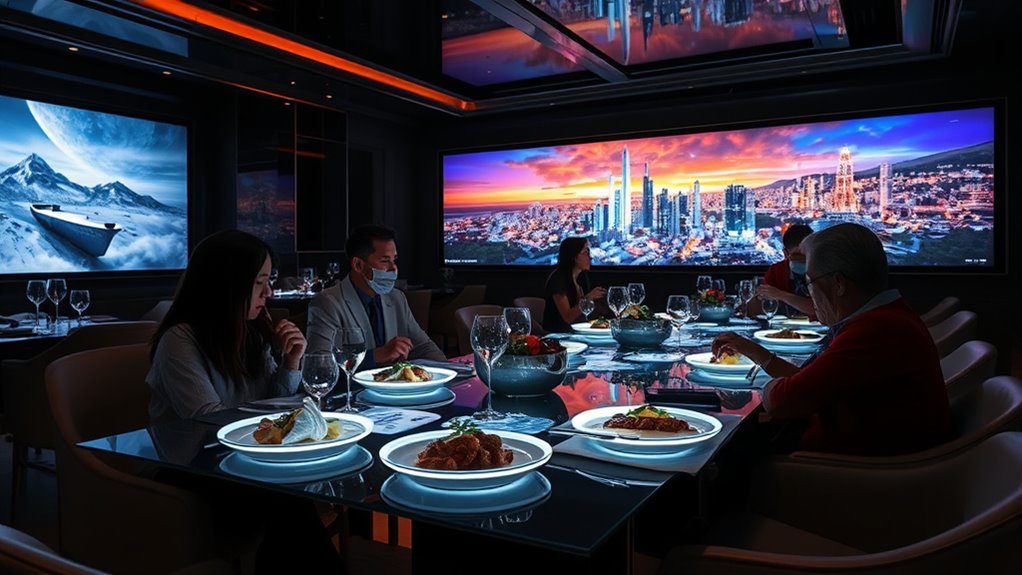
Technology has transformed dining experiences more rapidly than ever before, blending innovation with tradition to create immersive moments. You now have the power to customize your meals with smart kitchen gadgets that adjust flavors and presentation in real-time. Digital menus and contactless ordering streamline the process, reducing wait times and enhancing convenience. Interactive tables and augmented reality menus engage your senses, making the dining journey more memorable. Chefs leverage advanced tools like 3D printers and precision cooking devices to craft intricate dishes that were once impossible. Integrating restaurant design elements with technology further enhances the ambiance and overall experience. This evolution not only broadens your culinary options but also deepens your connection to the dining experience. As technology continues to advance, your meals become more personalized, engaging, and memorable—redefining what it means to dine out.
Virtual Reality and Its Impact on Culinary Adventures
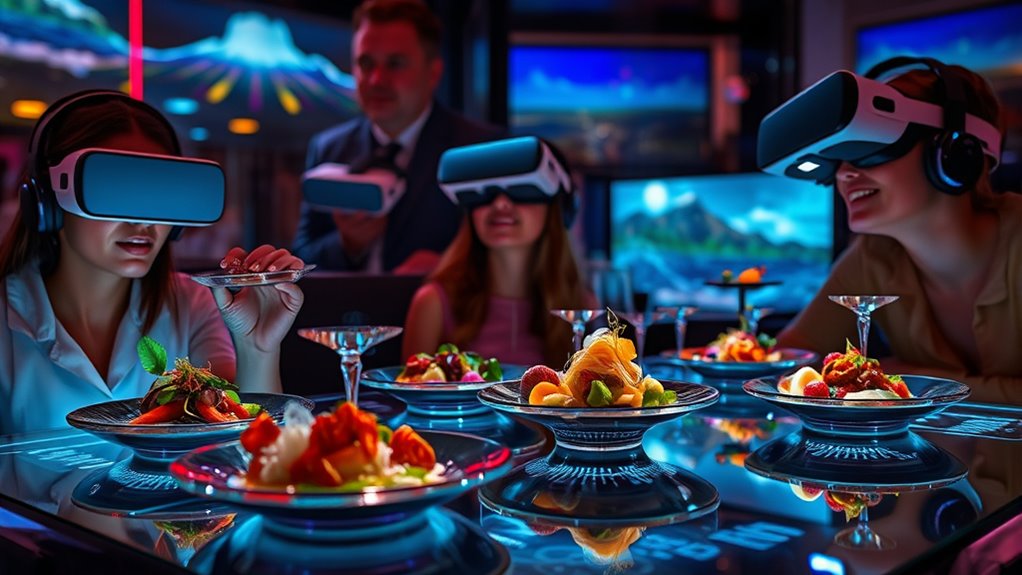
Virtual reality (VR) is revolutionizing how you explore culinary worlds, transporting you beyond the limits of traditional dining. With VR, you can virtually visit famous restaurants, farms, or exotic locations without leaving your seat. Imagine tasting a dish while immersed in a virtual vineyard or strolling through a bustling street food market across the globe. This technology creates immersive experiences that heighten your senses and deepen your connection to food. Chefs and restaurants now incorporate VR to tell stories behind their dishes, enhancing your appreciation and engagement. VR also allows you to participate in interactive cooking classes or culinary tours from anywhere. By blending sensory immersion with education, VR transforms dining into an adventurous, multi-sensory journey you actively participate in. Hours Today List resources can help you find local venues experimenting with these immersive dining experiences.
Augmented Reality: Bringing Food to Life

Augmented reality (AR) takes the immersive dining experience further by bringing food to life right on your plate. With AR, you can see interactive 3D visuals overlayed onto your meal, transforming how you perceive your food. Imagine watching a sizzling steak turn into a detailed virtual chef demonstrating how it was cooked or seeing ingredients floating around your dish, explaining their origins. This technology enhances your understanding of ingredients and cooking techniques while adding entertainment. Some restaurants use AR glasses or smartphone apps to create these effects, making every bite more engaging. AR not only elevates the sensory experience but also sparks curiosity and conversation, creating a memorable dining moment. It’s a powerful tool that combines education and entertainment seamlessly on your plate. Additionally, the integration of trustworthy insights ensures that the information provided is reliable and enhances your overall dining experience.
Interactive Installations and Their Role in Modern Restaurants
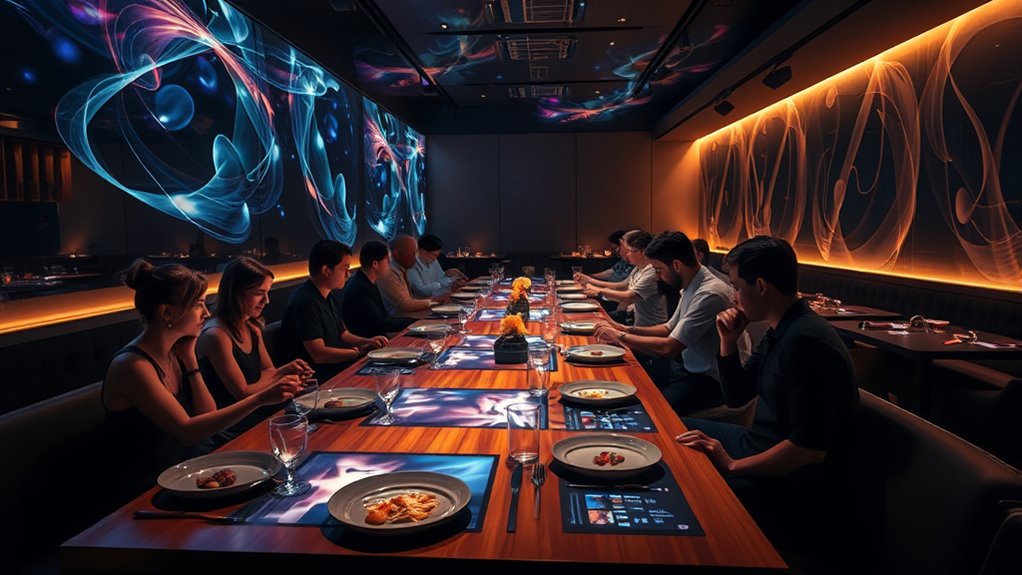
Interactive installations are transforming modern restaurants into immersive environments that captivate diners. As you dine, these installations engage your senses through dynamic visuals, responsive displays, and interactive elements that respond to your movements or choices. They create an engaging atmosphere, making your meal more memorable and unique. For example, digital walls might display evolving artwork or storytelling elements synced with your course. Touchscreens or motion sensors allow you to manipulate visuals or participate in the ambiance, adding a personal touch to your experience. These installations foster a sense of participation, transforming passive eating into active entertainment. They also encourage social interaction, as groups can collaborate or compete with the interactive features. Incorporating innovative interior design ideas into restaurant spaces enhances these immersive experiences, making them even more captivating. Overall, these installations elevate dining from mere sustenance to an engaging, memorable event.
Sensory Stimulation: Engaging Multiple Senses at the Table

As interactive installations enhance visual and tactile engagement, they also open the door to a richer, multisensory dining experience. You’ll find that combining sights, sounds, textures, and even smells heightens your enjoyment, creating a memorable moment. For example, ambient sounds or subtle fragrances can complement your dishes, stimulating your sense of hearing and smell. Textural elements, like unique plate surfaces or edible garnishes, invite touch and taste to work together. This sensory layering deepens your connection to the meal, making each bite more vivid. Incorporating sensory stimulation into your dining setup can elevate the overall experience. By engaging multiple senses simultaneously, you’re not just eating—you’re immersing yourself in an experience that heightens flavors, evokes emotions, and transforms a simple meal into a mesmerizing event.
Innovations in Tabletop Technology and Their Uses
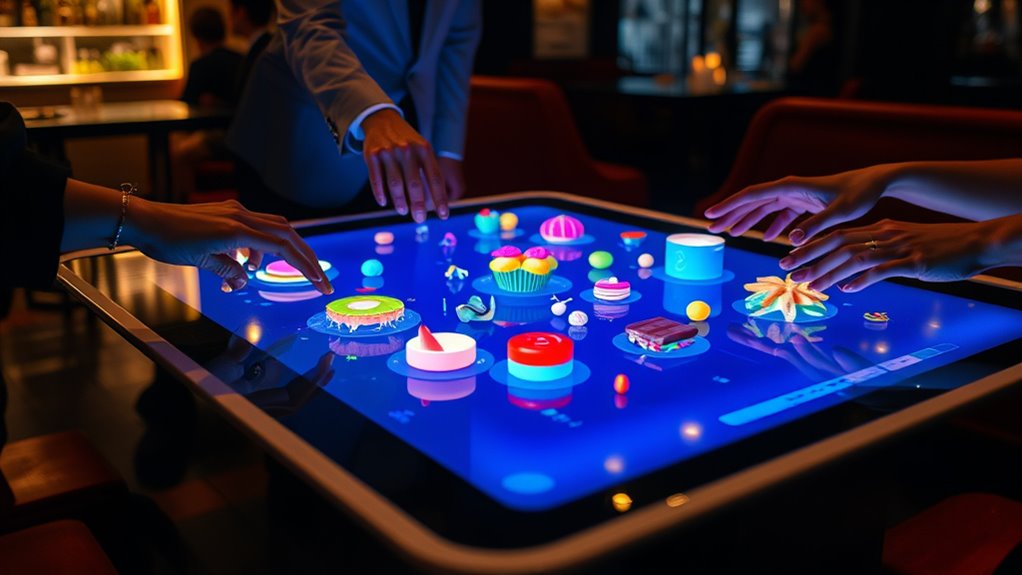
Tabletop technology is transforming how you experience dining, making every meal more interactive and engaging. Interactive surface displays allow you to explore menus and customize orders right at your table, while augmented reality menus bring dishes to life in front of you. These innovations create a more immersive and personalized dining experience that keeps you curious and involved. Incorporating modern elements and antiques can also enhance the ambiance, blending tradition with innovation for a truly memorable meal.
Interactive Surface Displays
Innovations in surface display technology are transforming the dining experience by making it more engaging and personalized. Interactive surface displays allow you to manipulate menus, order food, and even customize dishes directly on the table. These touch-enabled surfaces respond instantly to your gestures, creating an intuitive experience that blends digital and physical elements seamlessly. You can explore detailed images of dishes, see ingredient information, or suggest modifications effortlessly. Some systems even incorporate multi-user interaction, so your group can collaborate on selections simultaneously. This technology not only streamlines service but also adds an entertaining element to dining, encouraging curiosity and engagement. Additionally, the integration of pinball mechanics concepts into surface displays can introduce playful, game-like features that enrich the dining atmosphere. As a result, your meal becomes a more dynamic and immersive experience, redefining how you connect with food and the restaurant environment.
Augmented Reality Menus
Augmented reality menus elevate the dining experience by bringing digital content directly into your view of the physical table. With AR, you can see 3D images of dishes, explore ingredients, and customize your order in real time. This technology helps you make informed choices without flipping through paper menus. Plus, it adds an interactive element that makes dining more engaging. You might also discover chef specials, watch videos of how dishes are prepared, or view wine pairings right on your table. AR menus foster a more immersive, personalized experience that bridges the gap between digital and tactile. As a result, dining becomes more enjoyable, informative, and memorable. Here’s what AR menus offer:
- Visualize dishes in 3D before ordering
- Customize ingredients and portions
- Access detailed nutritional info
- Watch cooking or pairing videos
- Discover chef recommendations
An additional benefit is the ability to incorporate nutritional information, helping diners make healthier choices during their meal.
How Immersive Tech Is Transforming Themed Dining Venues

Immersive technology is revolutionizing themed dining venues by creating more engaging and interactive experiences for guests. You no longer just sit and eat; instead, your environment responds dynamically to your presence. Projection mapping transforms walls and tables into stunning, animated scenes that match the theme, pulling you into a different world. Virtual and augmented reality add layers of storytelling, allowing you to explore fantastical landscapes or historical settings right from your seat. Interactive tables and smart lighting heighten your senses, making each moment memorable. This technology enhances immersion, making dining more than just a meal—it becomes an experience. As a guest, you become part of the story, increasing enjoyment, engagement, and connection to the theme. Incorporating themed decor elements such as rustic accents and vintage-inspired details further deepens the sense of place and enhances the overall immersive atmosphere.
The Future of Food Pairing With Immersive Experiences
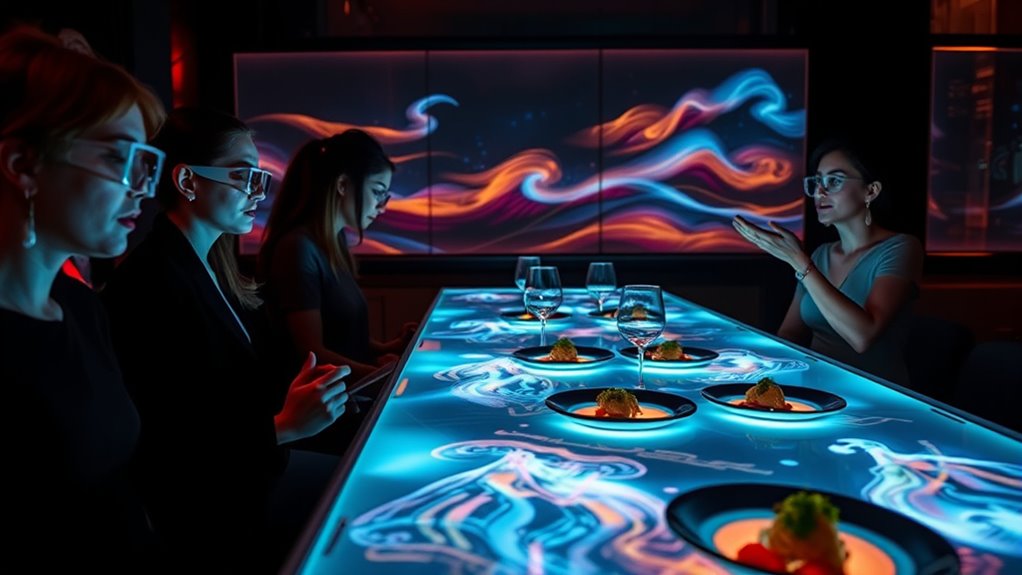
Imagine enhancing your taste experience through multisensory cues that heighten flavor perception. Virtual pairing environments can transport you to different settings, making each bite more immersive. As technology advances, food pairing will become more personalized and engaging than ever before. Incorporating market trends and innovative strategies from private equity can further propel this sector into new realms of experiential dining.
Multisensory Taste Enhancement
As technology advances, chefs and food scientists are exploring innovative ways to engage multiple senses simultaneously, transforming how we experience flavor. Multisensory taste enhancement heightens your dining experience by combining sight, sound, smell, touch, and taste. This approach deepens flavor perception and creates memorable moments. Techniques include using scent emitters to complement dishes, incorporating textured elements to add tactile interest, and pairing sounds with flavors to influence your perception. You might notice:
- Aromatic infusions that amplify taste
- Textured foams adding contrast
- Visual cues that set expectations
- Ambient sounds enhancing mood
- Temperature play to intensify sensations
Virtual Pairing Environments
Virtual pairing environments are transforming how you experience food by immersing you in digital worlds that enhance flavor perception and emotional connection. These virtual spaces combine visual, auditory, and tactile cues to create tailored sensory experiences. Imagine tasting wine while surrounded by scenic landscapes or savoring chocolate as gentle ocean waves play in the background. This technology breaks traditional boundaries, allowing you to explore infinite pairing possibilities.
| Sensory Element | Example Experience |
|---|---|
| Visual | Virtual vineyard tour |
| Auditory | Ocean sounds complementing desserts |
| Tactile | Haptic feedback mimicking textures |
| Flavor | Synchronized flavor bursts |
Challenges and Considerations in Implementing Tech-Driven Dining

Implementing tech-driven dining experiences brings a range of challenges that establishments must carefully navigate. You’ll need to contemplate costs, as cutting-edge technology can be expensive upfront. Technical glitches are another concern, risking interruptions during service. Staff training is essential to guarantee smooth operation and customer satisfaction. You also face potential resistance from staff or customers hesitant to adopt new tech. Additionally, maintaining data security and privacy becomes critical as you handle customer information.
Implementing tech-driven dining faces costs, technical issues, staff training, resistance, and data security challenges.
- Managing high initial investments
- Ensuring reliable tech infrastructure
- Training staff effectively
- Overcoming resistance to change
- Protecting customer data and privacy
Case Studies of Pioneering Experiential Restaurants

Pioneering experiential restaurants are redefining dining by blending innovative technology with immersive storytelling. Take Ultraviolet in Shanghai, where you’re transported to a multi-sensory environment that combines projection mapping, sound, and scent to enhance each course. Or consider Alinea in Chicago, which uses augmented reality to reveal hidden layers of flavor and presentation, creating a dynamic dining experience. In Japan, Narisawa incorporates nature-inspired tech to simulate seasonal changes, immersing you in a landscape that evolves with each dish. These restaurants don’t just serve food—they craft memorable journeys by integrating technology seamlessly into their narratives. Their success demonstrates that combining storytelling with tech creates deeper engagement, transforming dining into an art form and setting new standards for the future of experiential eating.
Frequently Asked Questions
How Does Immersive Technology Influence Customer Satisfaction and Repeat Visits?
Immersive technology profoundly boosts customer satisfaction by creating memorable, engaging experiences that stand out. When you use virtual reality or augmented reality, you make dining more interactive and fun, encouraging you to stay longer and enjoy the moment. This excitement often leads to repeat visits, as you associate the restaurant with innovative entertainment. Overall, immersive tech transforms dining into an extraordinary event, making you more likely to return and recommend it to others.
What Are the Safety Concerns Associated With High-Tech Dining Environments?
You should be aware that high-tech dining environments bring safety concerns like equipment malfunctions, data breaches, and sensory overload. You might encounter risks from complex devices that could cause physical injuries or discomfort. Additionally, sensitive customer information could be vulnerable to hacking. To guarantee safety, always follow proper protocols, regularly maintain equipment, and stay informed about cybersecurity measures. Prioritizing these steps helps protect both you and your guests.
How Accessible Are Immersive Dining Experiences for People With Disabilities?
Think of the quest for inclusivity as a journey through a modern labyrinth. When it comes to immersive dining experiences, accessibility varies. Some venues actively incorporate features like tactile guides, audio descriptions, and adjustable tech, making it easier for people with disabilities to enjoy. Yet, not all venues are prepared. You’ll find that with awareness and innovation, these experiences can become more universally welcoming, opening doors for everyone to indulge fully.
What Is the Cost Impact of Integrating Advanced Tech Into Restaurant Operations?
Integrating advanced tech into your restaurant can boost efficiency and customer experience, but it comes with costs. You’ll need to invest in hardware, software, and staff training, which can be substantial upfront. Ongoing maintenance and updates also add to expenses. However, these investments can pay off through increased customer satisfaction, streamlined operations, and potential revenue growth. Carefully plan your budget to balance tech enhancements with your overall financial goals.
How Do Cultural Differences Affect Acceptance of Immersive Dining Concepts?
Imagine a bridge connecting worlds—cultural differences shape how you cross into immersive dining. You find that in some cultures, you embrace storytelling and multisensory experiences, viewing them as respectful and exciting. In others, tradition and familiarity may resist change, making acceptance slower. You must adapt your approach, respecting local values and preferences, to guarantee your innovative concepts resonate universally and forge genuine connections with diverse diners.
Conclusion
As you explore the world of experiential dining with immersive tech, you realize it’s a game-changer that reshapes how you savor every bite. By blending cutting-edge innovations with your senses, these venues don’t just serve food—they serve memories. While challenges exist, the sky’s the limit for creativity. Embrace this evolution, because in the world of immersive dining, it’s truly a case of thinking outside the plate to stay ahead of the curve.
